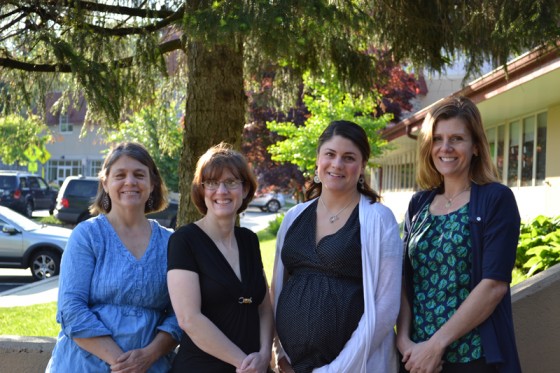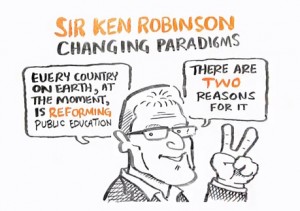The ultimate accomplishment of our year-long, job-embedded professional learning journey, The Connected Learner Experience, is the action research project that each team completes and presents at our year-end culminating celebration. Action research is a process in which our educators collaboratively examine their own educational practice systematically and carefully. They work together to identify a problem within their school or community, and then collaboratively to solve it. Action research is meaningful, positive, and reflective. It is data-driven, action-based, improvement-focused, and it’s transformative.
This post is part of a series of featured action research projects from our 2011-12 teams as they prepare for their culminating presentations. First up is this interview with our team from The Baldwin School and their 3D classrooms project.
Established in 1888 by Miss Florence Baldwin, who was “dedicated to the tradition of academic excellence in education for girls and young women.” The Baldwin School will celebrate its 125th anniversary in 2013. This diverse school enrolls more than 550 students in grades Pre-K through 12 with an average class size of 14, and many students having dual citizenship.
View this exciting sneak peek into their project, entitled Go 3D!
Your action research project tackled the problem of pushing teachers to expand what they do beyond the traditional classroom into a “3D classroom” and how to showcase the interesting things teachers did in this capacity. Tell us a little bit about what a 3D classroom means to you.
To me, a 3-D classroom means taking the relationship between teacher and student to a higher level—adding a third variable to the equation. This variable can be introducing or connecting with a different subject (interdisciplinary), connecting with other people from students to professionals (collaboration) and/or adding to the possibilities of student production (creativity).
What made you aware of this particular challenge in your school? Why did you land on this issue as the focus of your action research project?
We decided to start from the positive. We didn’t want to focus on what we weren’t doing; we wanted to take a close look at what we were doing and find some hidden gems of lessons within our school. We found several. In order to communicate what elevates these lessons from the educational norm, we needed a type of label and a flexible definition for our “hidden gems.” “The Three-Dimensional Classroom” fit the bill.
Our group represented many areas of the schoolhouse, so it seemed our project would necessarily be on the theoretical side to include everyone. I think as a collective team that was our natural bent anyway. This topic isn’t limited to a particular task or a specific grade: It could reverberate throughout the school as we undergo curriculum changes. Perhaps the situation of the school reinventing itself (from the test-oriented AP program to personal inquiry and interdisciplinary studies) influenced us more than we realized at the time.

From left to right: Janice Wilke, Laura Blankenship, Jessica Davis, and Diane Senior. Not pictured: Kelly Grimmett
Tell us a little bit about the process you went through during your journey through PLP’s professional development this year? How did your action research come together? Who did what and how did you identify who would be good at different aspects of the project?
It was essential for us to meet regularly and build a genuine social relationship. I can’t overemphasize this point. We enjoyed sitting down and having coffee together, checking in on each other’s week and life situations. I feel a sense of trust and respect builds from this personal awareness, and then philosophical discussions and more tangible results can flourish. This holds true for committees and for classrooms. We had a strong leader who held us all together and kept us on task. Individuals naturally reached for their own enthusiasms and one piece of the project would stimulate discussion in another. The truth is everyone has something worthwhile to say about everything, so listening and trusting each other helped shape the different aspects of the project into a more coherent whole.
What was your biggest revelation or aha moment during this year’s action research?

The team was highly inspired by Sir Ken Robinson's "Changing Paradigms of Education" talk.
I can only answer for myself on the “aha moment”; probably it was different for each of us. For me, it was the thought that in a truly collaborative classroom, the traditional definitions of teacher and student dissolve. So if I am not the person “in charge,” then what am I? I don’t like the phrase “guide on the side”; I think there is more to being a teacher than that. So what exactly is my function? (Janice Wilke)
Perhaps, opening myself up to wondering and exploring possibilities alongside my students and not providing answers but instead serving as a sounding board for their ideas best defines my role for a certain percentage of classroom time. This could happen as a whole group or on a one-to-one basis. When I see students develop their abilities to wonder and ask really great questions, I feel inspired. I know that their learning will continue long after they walk out of my class. (Diane Senior)
For me, it was realizing that I didn’t have all the answers. I feel this every day in my computer science classes (which are new to me and to the school), where I’m really only a week or so ahead of my students. But in the tech classes I teach, and in working with faculty, I often feel that I need to have all the answers. Realizing that my team members were smart and capable and had really wonderful ideas was a relief and a wonderful thing to experience. I’ll admit that it was uncomfortable at first–I like being a know-it-all!–but it added so much to our experience, and I’m glad I was able to let that happen. They really were great people to work with, and I truly appreciate the opportunity to get to know them better. (Laura Blankenship)
How did the concepts and strategies you learned during your PLP journey help you along the way?
I think it helped to take a step back. My team wanted to accomplish something immediately–like by December. But stepping back meant we refocused and came up with a better idea, one that I think will benefit our school, and won’t languish in a folder or on a web site somewhere.
What was a major challenge or roadblock you encountered during your project? How did you mitigate this difficulty?
The major challenge, initially, was time and a clear sense of purpose. It was up to us to find time and create a sense of purpose, and so we did.
What was the most positive or transformative thing to happen as a result of your project?
A positive thing to emerge from our project was a sense of connection—working together created a feeling of “recognition” as we saw each other in different contexts throughout the day.
Another transformative thing to happen during our project was thinking about how to take it forward; what else it could become. We will morph into a committee on “innovative teaching” for our school’s self-study year for the re-accreditation process.
Do you think this project will have implications into the future? Is it ongoing?
The project will definitely have implications for the future. We hope to bring part of it to new faculty orientation as well as to committees that are forming now on technology and innovative pedagogy (as mentioned above). Also, the PLP team will become leaders for the rest of the faculty in terms of implementing our ideas. It’s going to be very exciting!
How has being a part of PLP changed you as a teacher or leader?
As a “leader,” I think the project gave me more courage to be a “content creator” for the the school’s website and make stronger connections to other concerns, such as alumni relations. It is a bit odd to think of creativity and collaboration as a type of leadership, so maybe the traditional idea of what a leader is can also undergo a transformation. As a teacher, I think it taught me to sit back a bit more and stop trying to supply answers for my students. The students can supply their own answers and then we can consider the merits and possibilities of each on their own terms and in a variety of contexts. (Janice Wilke)
I feel empowered to share exciting and innovative pedagogical practices and to serve as a model for others who want to take a calculated risk and try something new. (Diane Senior)
I have to say that though I’ve been called a leader and have had leadership roles in the past, I tend to shrink from such roles as I prefer to be simply a significant contributor rather than the person leading the pack. My team members made taking on this role challenging but successful. For the first time, I felt like I could ask things of my team and I would get more than I asked for. I’m really proud of what we accomplished. As Janice said, I think letting students (and faculty) supply their own answers was something I really learned from this experience. I already do that in many areas of my teaching, but I feel I can do more, and I feel that it actually worked with this group. (Laura Blankenship)
Join us for a year of action research and learning
Check out the complete details on The Baldwin School’s 3D Classroom project here. Like the idea of using action research to solve problems in your school? We have built an entire year of job-embedded learning around action research and social media tools called The Connected Learner Experience. Teams are forming now. Check it out here and join us for 2012-13.
Latest posts by Powerful Learning Practice (see all)
- Hurry, you do not want to miss out on this… - November 3, 2020
- Resist the Urge to Quit Prematurely - October 26, 2020
- Let’s Move Past Feeling Disconnected from Your Students. Words Matter - October 24, 2020

